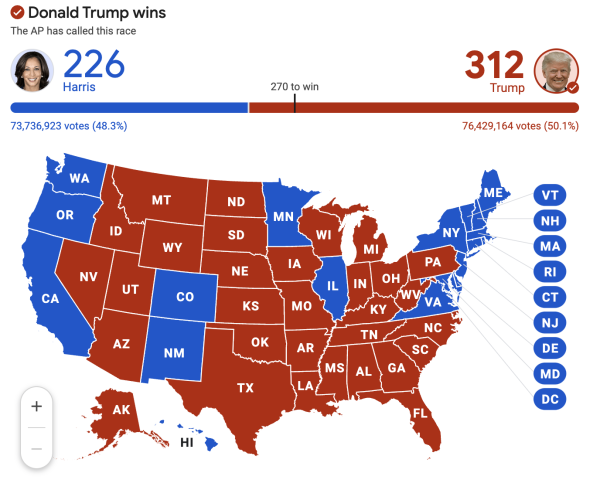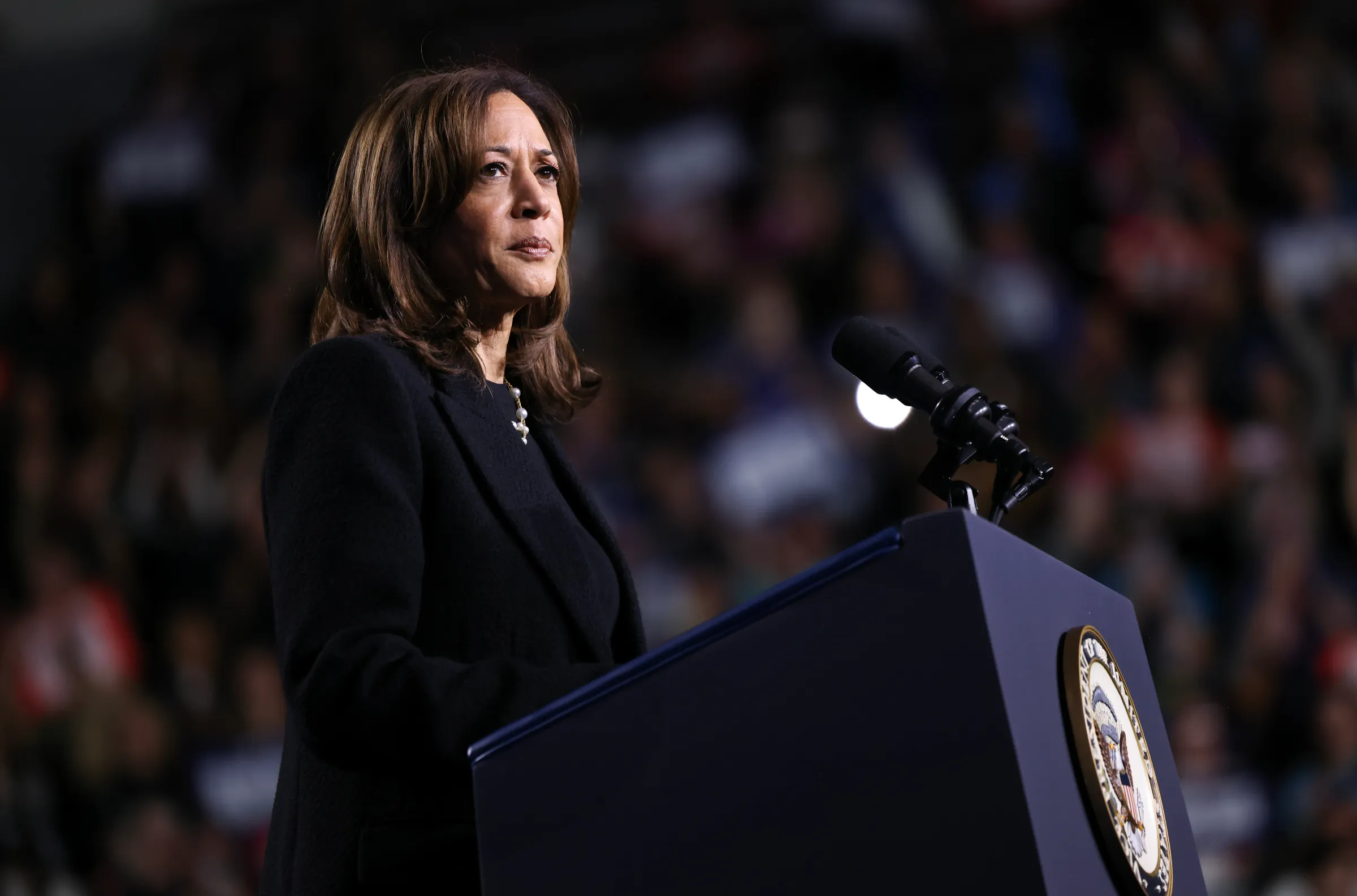At 1:47 AM on October 6th, Fox News became the first major news outlet to call the 2024 presidential election in favor of Republican candidate and former President Donald Trump. Trump defeated current Vice President and Democratic Nominee Kamala Harris, securing 295 electoral votes and 50.7% of the popular vote (The New York Times).
For many, Trump’s victory echoed his 2016 win, when he, a political outsider, defeated former Secretary of State Hillary Clinton although polls widely projected a Clinton victory. This time, however, pollsters approached the race with greater caution, frequently labeling it a “toss-up.” Still, major publications like the New York Times showed Harris with a slight edge both nationally and in critical swing states such as Michigan and Wisconsin.
Many anticipated that it would take days to determine whether Harris or Trump would become the 47th president. But they were mistaken. Less than six hours after polls closed, the outcome was clear. Trump achieved decisive wins across all seven key battleground states—Arizona, Georgia, Michigan, North Carolina, Pennsylvania, and Wisconsin—and surpassed Harris by a margin of 4 million votes (Associated Press).
In response to the election, many Democrats have been left wondering what went wrong.
I believe the answer lies in the Democrat’s fractured party identity.
In 2020, Joe Biden was able to rally voters on an anti-incumbency campaign. He built a coalition of traditional democrats, moderates, and progressives on the basis of defeating a common, clear enemy: Trump. This method worked.

Additionally, Biden used Pandemic induced chaos to leverage voters, with 25% of his votes coming from individuals who did not vote in the 2016 election (Pew Research). The Pandemic motivated centrist voters with a low sense of political efficacy. By Election Day, it had killed more than 200,000 Americans and, in turn, upended American life. (USA Today). Trump diminished the impact of the virus, frequently referring to it as “hoax.” The stance struck many centrists, motivating them to get out and vote. In swing states, this made all the difference.
Now, four years later, MHS math Lee and debate coach Jake Lee explains that the election results reveal a critical flaw in the Democrats’ current strategy: “the Democrats need to find their identity.”
The party is divided between two ideological wings—moderate conservatives and progressive liberals. This diversity enables figures as ideologically distinct as Joe Manchin and Alexandria Ocasio-Cortez to belong to the same party, despite significant differences in their political agendas and visions for America.
This ideological spectrum has led to a party at odds with itself. Are Democrats a coalition of moderate conservatives focused on climate action and domestic manufacturing? Or are they more like Lyndon B. Johnson-era liberals, advocating for the expansion of public welfare programs and wealth redistribution? For the party and their voter base, the answer remains unclear.
To overcome this internal crisis, Democrats must rally around a cohesive platform. Lee drew upon this, suggesting that Democrats rally around policies like “universal healthcare, universal basic income…por dedicate themselves to a central mission like public services.”
Due to this lack of unity, Harris struggled to take definitive policy stances during her campaign. Without a clear platform, her messaging lacked direction and failed to inspire confidence in her vision for the country. For Democrats to succeed, they need to define who they are and what they stand for.
Lee argues that Harris believed “she could win this election based on a popularity contest rather than taking actual political stances…her stance on the economy was missing.” According to exit polls from CNN, 64% of people who voted for Trump claim that their current financial situation is worse than it was four years ago, blaming the economy on the incumbent administration Harris is tightly associated with.
An anonymous student and Trump supporter corroborated the teacher’s claims, stating that “the economy isn’t in a good place right now” and citing this as their primary reason for backing Trump.
In returning to the anti-incumbency argument, Harris failed to separate herself from Biden, citing that the country would look “not that different” under her administration in a live interview with The View.
In failing to take clear stances on policies, Harris’s campaign strategy was deeply flawed. Harris had the leverage to take credit for Biden-administration economic victories.
For example, the economy has seen the largest growth in the 21st century under the Biden Administration. As Biden’s time in office comes to a close, the unemployment rate is the lowest it’s been in 50 years, 16 million jobs have been created, the GDP is up 12.6%, and inflation is down to 2.1% (The White House).
Lee claims that Harris “didn’t do enough outreach or show enough of herself,” only doing “broadcast news whereas the Trump campaign utilized podcasts, tiktok, live streams, and influencers to showcase their message.”
Trump was able to rally voters in places like Texas and Florida at the same impressive rate Biden was able to attract educated, suburban women in the 2020 election.
Harris was doomed from the start. Her misfortune is not entirely her fault. If Biden had stepped down in January, giving the Democrats time to hold a proper primary, the party would at least have had a chance to find a leader who represents them and therefore had potential to win.
The final aspect of Trump’s campaign that set him apart is what Tyler Prozes (’25) describes as “vibes.”
Harris attempted to make her campaign seem ‘hip,’ producing merchandise that resembled popular artist Chapell Roan designs, running a TikTok account with 9.2 million followers that utilized various trends and jokes from the app to make political statements and appeal to younger demographics.
Following Biden’s resignation in July, these tactics worked. The Democratic party united around Harris. For a brief minute, it seemed the party had found the enthusiasm and energy it had during the early years of the Obama administration. Harris saw 1.5 million new donors (The New York Times). Many of these individuals donated small sums of money but their contributions represented their faith in Harris.
Trump’s tactics, though, proved to be more sustainable. He has moved away from traditional campaigning strategies. In September, for example, he sent conservative commentator Tucker Carlson to battleground districts in and surrounding Grand Rapids, Michigan. Carlson convinced Republicans to download an app–10xVotes–to help them locate non-voting, conservative friends and family (CNN).
In other parts of Michigan the Trump campaign held “election integrity” training. In these workshops, campaign representatives taught conservatives to be poll watchers, drawing upon Trump’s claims of corruption in the 2020 election (CNN).
Trump is vulgar and direct. He is willing to do whatever it takes to appease the largest possible voter base and he is willing to take risks in order to reach broader demographics of voters. He knows this. Therefore, he spent the past year working on motivating those disengaged from politics rather than flipping voters who turned on him in 2020 (The Guardian).
The 2024 presidential election should serve as a wake-up call for Democrats. If the party hopes to regain the trust of voters, it must define its identity and present a bold, cohesive vision for America. This means taking clear stances on critical issues, embracing innovative campaign strategies, and engaging voters where they are. The time for vague messaging and fractured leadership is over—Democrats must step up, rally around shared principles, and fight for a future that inspires belief and action.









